Why go barbel fishing?
Sometimes referred to as the freshwater bonefish – the aim of barbel fishing is to hook up to a muscular, streamlined and frighteningly-powerful fighter that lives in flowing water (double trouble).
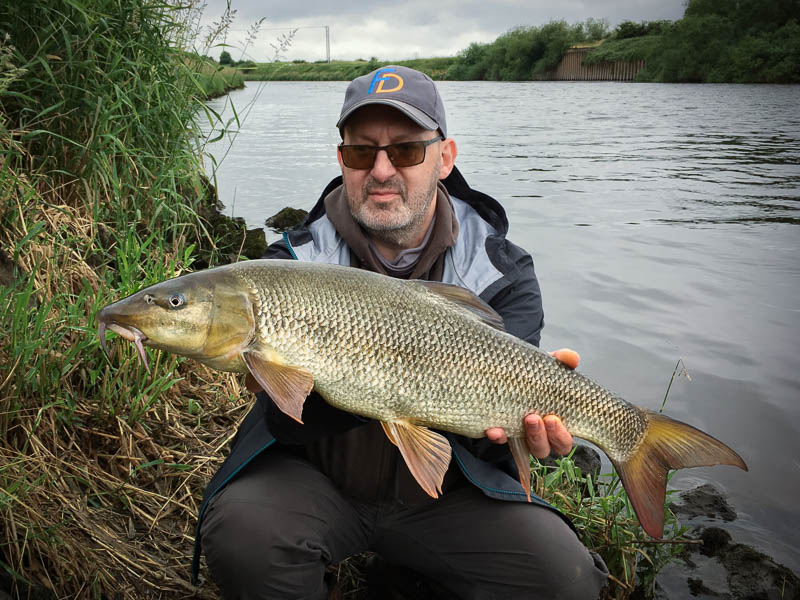
Our Target Species: Barbus barbus
There are some very complicated arguments over how many species and sub-species of Barbel there are in Europe. At the very least there are supposed to be three main species (“standard” Barbel, plus Mediterranean Barbel and Thracian Barbel). There are at least a further six (or as many as a total of 12) sub-species or closely-related species. Most are quite small fish of around 30-cm.
However, within that mix, there’s the largest and most widespread barbel species Barbus barbus which we have in the UK (this species is the main focus of this article). Originally native to the Trent and Thames, it has now spread (i.e. been introduced) to other river systems in England and Wales.
Barbel Fishing Basics
Tackle & Bait
With the exception of a few artificial (and somewhat controversial) stockings in some still waters - barbel fishing takes place in rivers; sometimes in very powerful flows for hard-fighting (but often wary) fish. This means tackle needs to be matched to the strength of the river flow, how snaggy the swim is and the size/strength of the fish).
Although barbel can be caught using float fishing, free lining and even fly fishing – for this article we’re going to be focusing on bottom fishing tactics with leads and swim feeders.
Rods for Barbel Fishing
Small to medium rivers can be fished with a single rod setup but you may opt for a 2 rod setup where space allows. There are many, many rods out there which are up to the job from heavier feeder rods through “old school” Avon rods through to specifically designed barbel rods (many of which are available with a “twin top” featuring one top section with a quiver tip and another with a standard Avon style top).
A rod of 11’ to 12’ with a test curve of 1.5lb or 1.75lb (or a feeder rod rated to cast at least 3oz) is about right on all but the tightest of river venues for barbel fishing.
On larger rivers 12’+ rods between 2lb and 2.75lb test curves may be needed to contend with big flows, big fish and the stress of casting heavy feeders and leads.
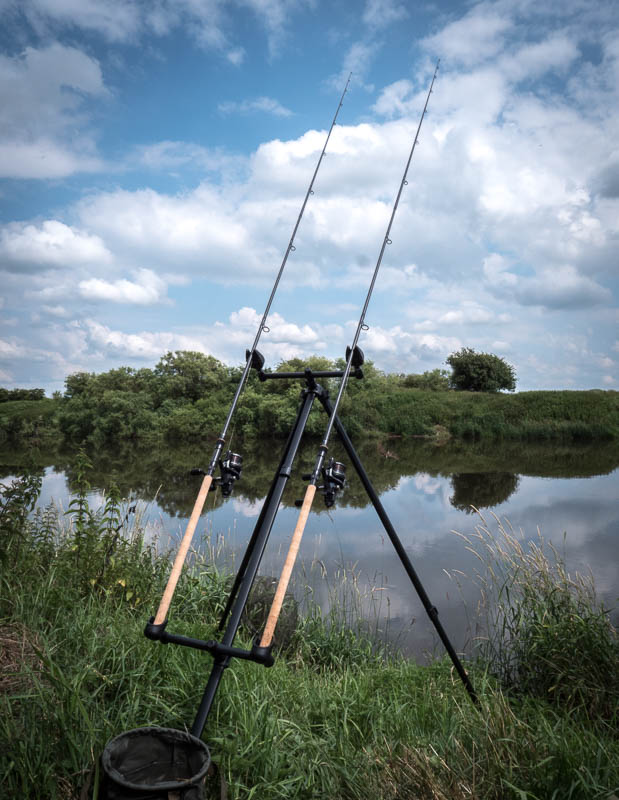
A pair of rods angled high on a tripod hold the line off the water in strong flowing water.
Barbel Fishing Reels
A reel with a baitrunner/freespool option is the best option...
Even when sat right on your rod(s), bites can be so savage that, without a free running spool to give a little (or a lot of) line, you could end up getting your rod pulled in!
In fact, if you intend to fish a two rod setup – free running spools are absolutely essential..
If you get a savage take while already playing a fish on your other rod, the free running spool will save your rod (and more importantly – the fish).
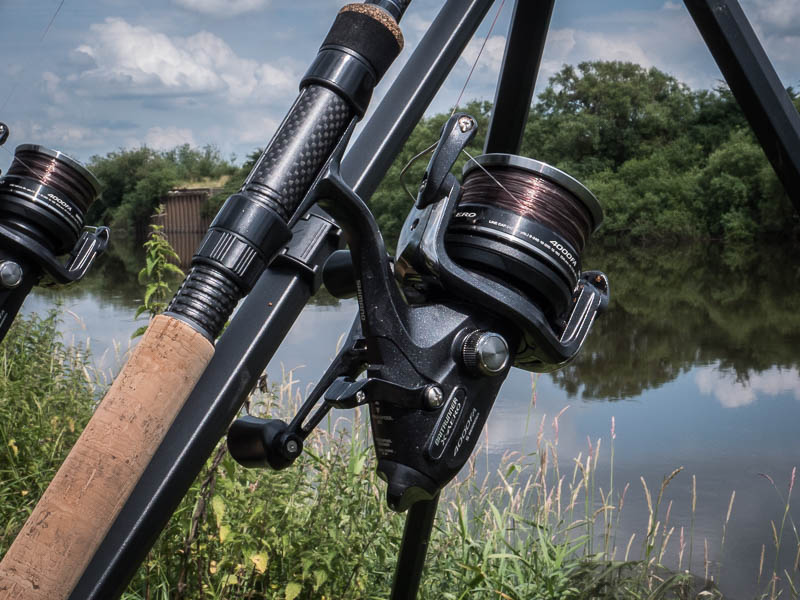
Baitrunner/free spool reels are a good option.
Speaking of savage takes... there’s a common saying among barbel anglers “in the know” when any newcomer asks how to distinguish bites from barbel from smaller silver fish...
If you’re in any doubt about those little twitches on the rod tip... simply wait for a three foot twitch!
If you need any pointers in making sure your reels are perfectly loaded, then check out our guide to loading your reel with line.
Line
Line for barbel fishing needs to be up to the job and that really depends on your chosen venue and size of fish. For smaller venues with mostly single figure (i.e. <10lb) fish with minimal abrasive snags such as sharp rocks, a reel line of 10lb nylon is a good choice. If in any doubt (about fish size or snags) it’s worth stepping things up to 12lb or even 15lb if the snags and fish are really large.
Hook lengths are worth experimenting with both in length and material. Fluorocarbon, nylon and braid can all be effective. Fluorocarbon is probably best in terms of abrasion resistance but is relatively stiff. Braid offers supreme suppleness but can be easily damaged on sharp snags. Nylon falls somewhere between the two.
In general it’s best to keep the breaking strain of your hook length somewhere near that of your mainline so something like 8lb and 10lb hook lengths with 10 lb and 12 lb reel lines respectively.

JP Top Tip
When it comes to length... if in doubt, go long! It’s not a well kept secret that may successful barbel anglers fish with hook lengths as long as 6 feet.
Long hook lengths can be a leap of faith from carp anglers and method feeder fishers who are used to hook lengths measured in inches rather than feet. Don’t worry! Start with at least 3 feet and don’t be afraid to go longer - all the way up to six feet if necessary.
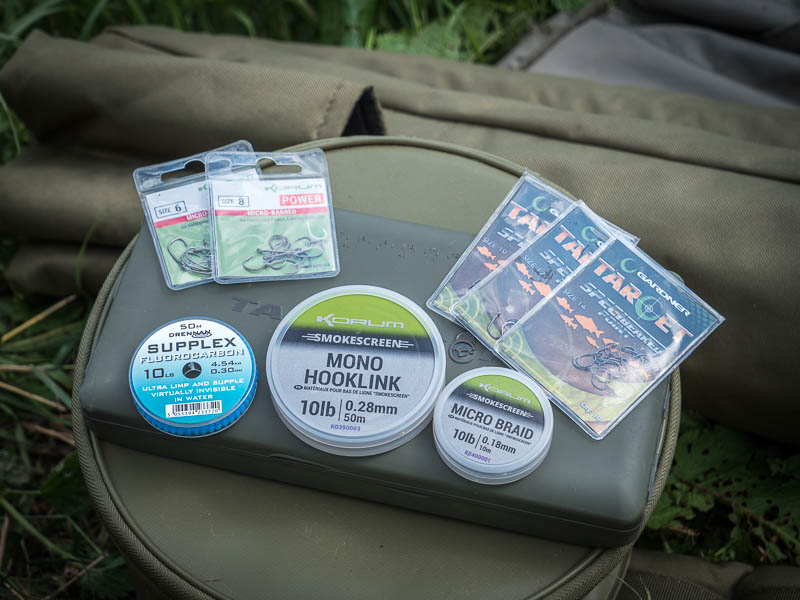
It's worth experimenting with hook sizes and hook length materials.
Hooks
Hook size should be proportional to your hook bait – but whatever the size, make sure to use strong hooks! Don’t fall into the trap of “loading for bear” with big hooks and big baits either. Although bigger baits will take fish(some anglers swear by a massive quarter tin of luncheon meat on the hook!), some very good captures can be had on small baits like corn, maize, meat and pellet etc. on hooks such as size 10, 12 or even 14. The important thing to remember is, whatever size hook you use, make sure it’s a strong one – there are plenty of great “specimen hooks” out there from most major brands.
Although we’d advocate barbless hooks in almost all of our fishing, when it comes to large carp at long range and big barbel – the jury is still out.
Regular “full sized” barbs have no place in our armoury but micro barbs can help maintain a solid hook hold in the soft mouth of a large hard fighting fish - and prevent any "sawing" action on the mouth (while coming out very easily after the fight).
In these specific situations we’ve witnessed barbless hooks moving around – sometimes the point going through the fish’s mouth a second time. A micro barb seems to prevent this while still being easily removed after capture.
It’s not just the hook size you should match with your chosen bait – if you’re hair rigging your bait, getting the right proportions for the length of hair can make a difference too. It pays to tie your own hook lengths rather than buying pre tied – that way you get to choose the exact proportions of the hair as well as the overall length of the hook length.
A great tip is to tie a small loop in a length of line (about the length you want your hook length plus 6”) and hair rig your chosen bait using the loop. Then use a knotless knot to tie on the hook with the hair rigged bait set exactly where you want it. Below is a video demonstrating the knotless knot:
Leads & Feeders for Barbel Fishing
There’s a lot of debate about barbel “spooking off” feeders or hanging well back and hoovering up the feed from a distance. If you’re fishing two rods it can pay to try a lead on your downstream rod in the same line of flow as your upstream rod with a feeder. Longer hook lengths are also good if you suspect fish are a little shy of your feeder. On single rod sessions either baiting up beforehand or making several casts with a feeder in short succession before switching to a lead can be an effective approach.

JP Top Tip
A really effective solution to the lead vs feeder problem in barbel fishing is a lead designed to carry a bit of feed. Going under names like “pellet leads” and “bait gripper leads”, these weights have the “stealth” of a lead with the advantage of introducing a little feed or flavour near your hook bait.
I find these tend to work well using something with a little extra flavour such as softened pellets with some extra flavouring liquids soaked in. They’re also great in high water where the lead holds bottom better than a feeder – press the softened pellets in really tight with plenty of stinky flavouring and the scent will attract fish to the area for the maximum possible time (which, of course, is totally dependent on how long it takes your pellet mixture to break down).
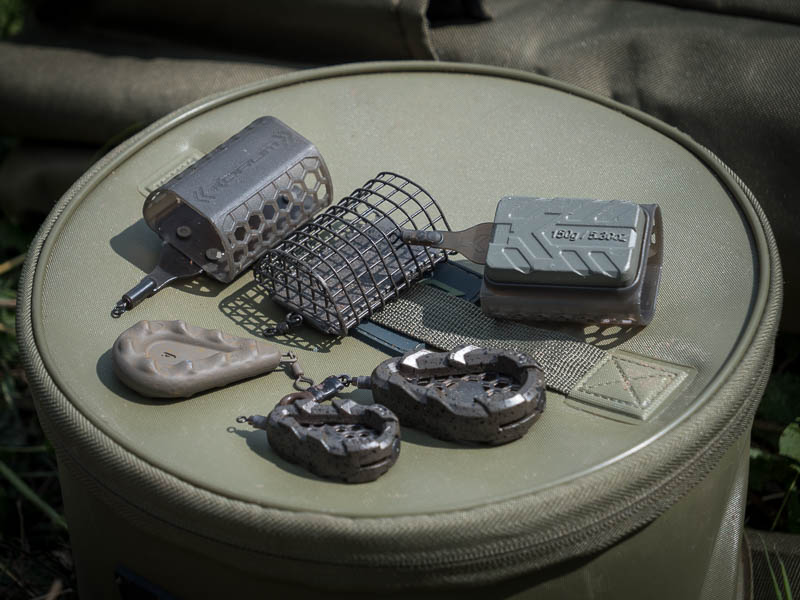
Whatever you need to get the bait there and hold bottom, chances are there's something available to do the job.
The size and weight of leads and feeders is really a case of “whatever it takes to hold bottom”. This could be a couple of ounces (even on a bigger river in low conditions) through to as much as 8oz or 10oz on a big/high river. Yeah you read that right... over half a pound of lead to hold bottom!
There’s a tactic often used by match anglers on rivers for holding bottom in a flow with the lightest weight they can.
The tactic involves “feeling the feeder/lead down on a tight line after the cast (which you should be doing anyway) but then, once the feeder (or lead) has settled, paying out some line to achieve a bow.
This relieves the direct pressure of a strong flow which will dislodge your weighted rig... this can be a SERIOUS PROBLEM as a feeder or lead bouncing along will often come to rest in a snag which can cost you your expensive feeder or more importantly a fish... not to mention the fish welfare issues of a baited rig stuck in a snag.
It should go without saying – but we can’t repeat this enough... ALWAYS fish “safe” rigs. This means a lead or feeder that can be easily released if your line snaps or the lead/feeder gets snagged.
A safe rig prevents fish towing around a heavy lead/feeder or worse still being tethered to a snag. There are plenty of rig components available for either running or semi-fixed setups.
Want More Rigs for your Coarse, Carp & Predator Fishing?
Before moving on to baits - I realise you might want to build rigs for more than just one species!
Clicking here or on the image or button below will pull up the free offer for my E-book for my "unfair advantage" bait fishing rigs and newsletter guidance:
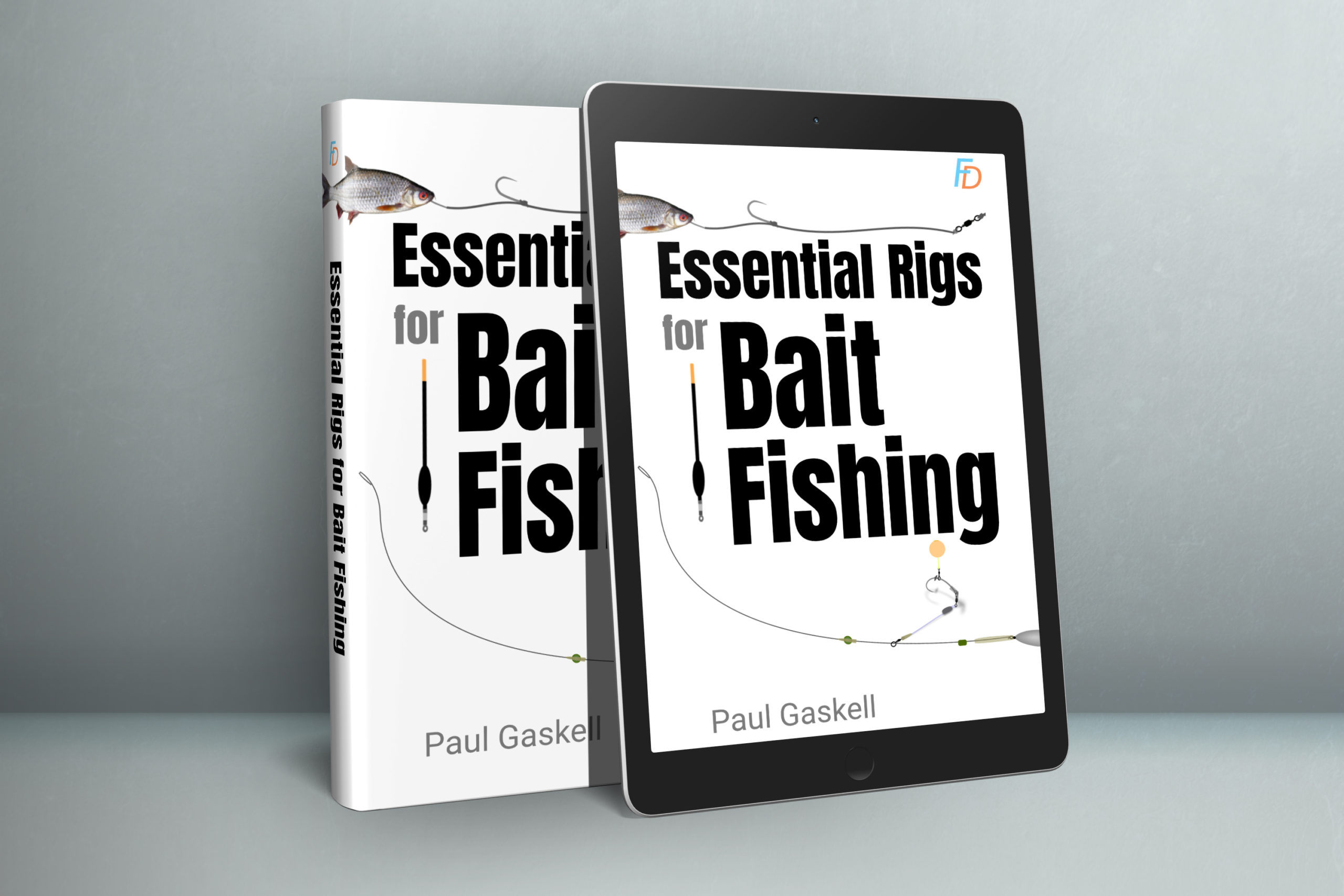
Bait for Barbel
It might be easier to list baits that won’t catch barbel (actually nothing springs to mind). In reality, bait choice is more often about what is practical than what the fish will eat.
The first consideration is other species. Barbel love maggots, for example, but you can end up with smaller silver fish cleaning out your bait before the barbel ever make an appearance. Tenacious baits that can withstand the attentions of smaller fish are a good call on the hook and a mixture of baits in loose feed is the way most anglers go.
Popular hook baits include meat (luncheon meat is synonymous with barbel fishing), drilled pellets, and boilies (meaty and fishy flavours being most popular).

Larger tenacious hookbaits like drilled pellets or boilie dumbbells can be useful to avoid smaller "nuisance" fish.
A sneaky trick for an extra edge is “cocktail baits” where you mix two baits (or more) on the same hook. A good example would be a pellet or boilie and a bunch of maggots on the hook.
Also worth a try is a pellet or boilie wrapped in a strong smelling paste.
Loose feed choice is not only governed by what other fish are around but also the strength of the current. There’s no point introducing a load of light bait such as casters for example that will be washed away in seconds after being introduced to a strong flow.
A classic barbel loose feed is a bed of hemp (often introduced with a “bait dropper”). This is still popular but in more recent years it is often supplemented or even replaced by feed pellets such as halibut pellets available in a range of sizes from as small as 2mm right up to 14mm or 18mm.
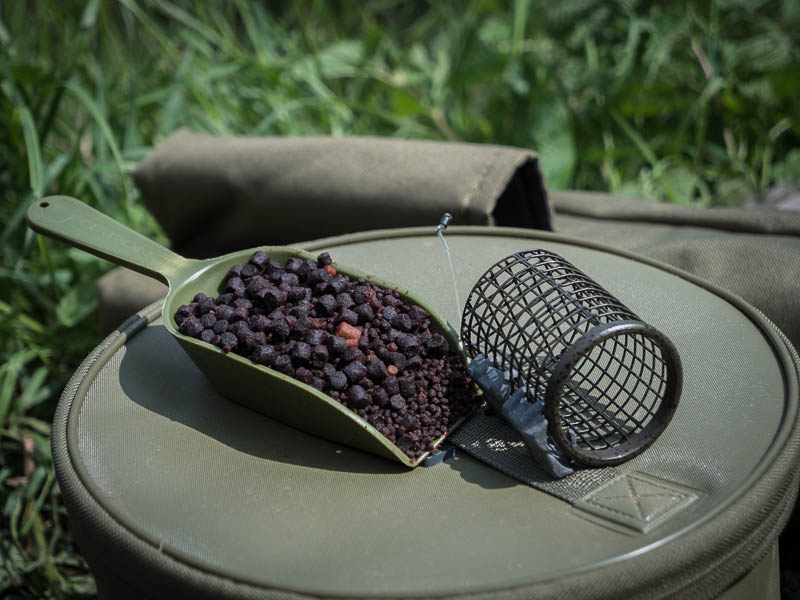
Feed pellets in a range of sizes and flavours have become a popular loose feed.
Halved or chopped boilies are also a popular (if more expensive) choice. It can pay to avoid using whole boilies in strong flow as they can just roll away out of the swim... a potentially very expensive mistake to make!
Most anglers opt for a combination of loose feed mixing any or all of the above and also including things like corn and maize. Strong smelling/flavoured groundbait is also good when combined with some of the above free offerings and can be good for binding things together if you’re introducing feed by hand or casting in several large feeders at the start of your session.
Locating Barbel
When it comes to locating fish, you can’t beat local knowledge. Asking at a local tackle shop is the “old school” way to get some intel but these days social media tends to be where most people head for their fishing info.
There are pros and cons to seeking your information on social media. It’s a massive resource with a huge reach but new barbel anglers can fall foul of “etiquette” on some forums and social media platforms. It’s worth browsing as much of the existing posts you can to glean information before posting questions like “where can I catch a barbel?” or “are there barbel around river X near town Y?”
Chances are those questions have been answered many times already if you do your due diligence and read through plenty of posts; don’t make yourself unwelcome asking questions that have been answered countless times already.
There are also successful anglers who are protective of their productive spots which they’ve invested a lot of time and money to find – if you get too “pushy” when trying to find out specific information you may find yourself on the receiving end of some expletive laden advice on where you can go (and that destination may not include many fishing opportunities).
Assuming you manage to get yourself on a river containing barbel locating a likely looking swim is the next step.
Barbel like water with a bit of flow to it, preferably with some cover. Gravelly bottoms are a great place to start (gravel means a good pace of water – otherwise it would end up silty or muddy). Beds of streamy weed like ranunculus over gravel are a classic barbel habitat. Overhanging trees or sunken/fallen trees are good places too. Weirs are another classic barbel fishing venue but don’t neglect natural features that create increased flow/oxygenation such as pinch points in the river channel or rocks and riffles at the heads of pools.
On larger rivers such as the Tidal Trent things can be a little less obvious (more on that later).Barbel fight so hard that fish welfare is particularly important. In addition to well as wetted mats (to prevent slime removal/loss) it is VITAL that you allow fish to recover as the FIRST thing you do post-fight.
The hard fight produces toxic lactic acid in the fish’s body (it’s the same stuff that makes our bodies ache when we exercise vigorously). If you lift a fish out of the water straight after that fight it’s the same as putting a plastic bag over the head of a sprinter who’s just run the 400m.
Most people could probably endure a bag over their head for a minute or two (don’t try it at home kids) but straight after a 400m sprint when gasping for breath could cause serious injury – even death.
So letting the barbel “get its breath back” for a few minutes in the landing net in the water before removing it from the water is essential.
It may also be necessary to support the fish for a while when returning it to the water – let the barbel decide when it’s ready to swim away, don’t just push it out into the river’s flow and hope for the best.
What Season is Best for Barbel Fishing?
It’s possible to catch throughout the coarse fishing season but in general, barbel are at their best in summer and autumn. Although larger specimens can show up at any time of day, on many rivers the largest fish often get caught in the hours of darkness. Maybe it’s because these “older and wiser” fish are a little more wary and only get fooled by our rigs when the light is low and visibility poor. Whatever the reason, it’s always worth planning for at least an hour or two of fishing after the sun goes down.
Multiple captures can come along anytime when you employ a good approach but the odds are more in your favour when there is some mild/warmish weather with good water levels (i.e. not low water conditions). Higher fish metabolism brought on by the warmth coupled with good oxygen and food levels that come with a little extra water in the river mean the fish will be feeding more enthusiastically. If I had to pick a favourite time for these conditions it would be early autumn but be ready to get out after a summer storm has “freshened up” the rivers too.
Seasons for coarse fish (i.e. non salmonid species) vary around the world but in England and Wales the closed season for coarse fish on rivers is from 15th of March to 15th of June (inclusive).
Daytime Barbel Fishing on the Tidal Trent
The tidal Trent needs strong tackle! Don’t be fooled by that slow flow if you arrive near high tide time... the flow can pick up within an hour or two and you can be caught out with shorter (sub 12’) and lighter (below 1.75lb TC) rods.
If you own a couple of 12’ carp rods they’d probably be up to the job but if you’re buying barbel rods for the Trent it’s worth considering test curves of 2lb and over. There are some nice rods available with two top sections of different test curves (2.25lb and 2.75lb for example) which can add a bit of extra versatility.
Line should be at least 12lb breaking strain nylon. Avoid braid mainline which can cut very easily on the sharp rocks lining much of the Tidal Trent and fluorocarbon can have issues with knot strength if your knots aren’t absolutely perfect. Consider upping the breaking strain to 15lb if you’re finding lots of snags in your chosen spots.
When it comes to hooks, the advice already given stands. Keep it simple, keep it strong!
Night time is the right time?
There’s a piece of advice that gets trotted out all too often when people talk about the Trent and that’s that the barbel mostly come out at night.
There’s no denying there are a lot of barbel caught on the Trent during the hours of darkness but that doesn’t mean daytime success is impossible. There’s been an influx of carp fishing influence in to the barbel world in the past decade or two and that’s brought some heavy handed rigs (at least for barbel during daylight) and a tendency to “bivvy up” for an overnight session – or longer.
Follow the advice in this article and you’ll have pretty good odds for fish in the daytime but nobody can deny that the hour or two before darkness and the first couple of hours after dark can be very productive – so it’s always worth bringing a head torch and planning on staying a little late – no need to camp out overnight to get the best of the sport.

Staying an hour or two after sunset can pay dividends.
The carp style approach also often comes with a “bait and wait” strategy where the angler introduces bait at the start of the session but the time between “top ups” can be a long one (some never bait up again).
There’s no denying this strategy works for many anglers but heavy handed rigs and camping out on a spot can lead to some long waits for a fish. Just to clarify what I mean by “heavy handed” rigs, I’m not saying your rig shouldn’t be strong but (coming from carp fishing to barbel) many anglers end up fishing shorter hook lengths, and semi-fixed “bolt rig” style with big hooks and baits where a long hook length (3’ to 6’) with running leads and (slightly) smaller baits would be more productive – especially during the day when terminal tackle and rigs will be more easily noticed by fish.
There’s nothing wrong with baiting up at the start of a session but if you don’t keep something going in throughout the session that effort could be wasted. Fish can move around a lot on the river and if you don’t give them a reason to stay (i.e. bait) they’ll move on elsewhere and find someone else’s. If you want to put in a significant amount of bait, high tide can be a good time as the river can slow right down (sometimes even flowing in the opposite direction). Bait introduced at high tide stays in your spot a little longer and that hour following a high tide can be a good time for some fish too..
Just because you put in a load of bait at high tide doesn’t mean you can forget about it though. Fishing a feeder on your upstream rod and casting every 15 to 20 minutes will keep a steady stream of free offerings and more importantly some attractive aroma flowing through your swim.
How to Feed Accurately
One thing from the carp world that really can be a game changer is using distance sticks (pictured below) to hit the same spot every time. Distance sticks are basically headless bank sticks placed a rod length apart allowing the angler to wrap around them to measure distance. Simply find a nice spot by either casting to a feature or “feeling around” with a lead then clip the line in your spool’s line clip. Now place the lead next to one of the distance sticks and wrap around them in a figure 8 (counting the wraps) until you reach the clip – you now have a distance measurement you can repeat.
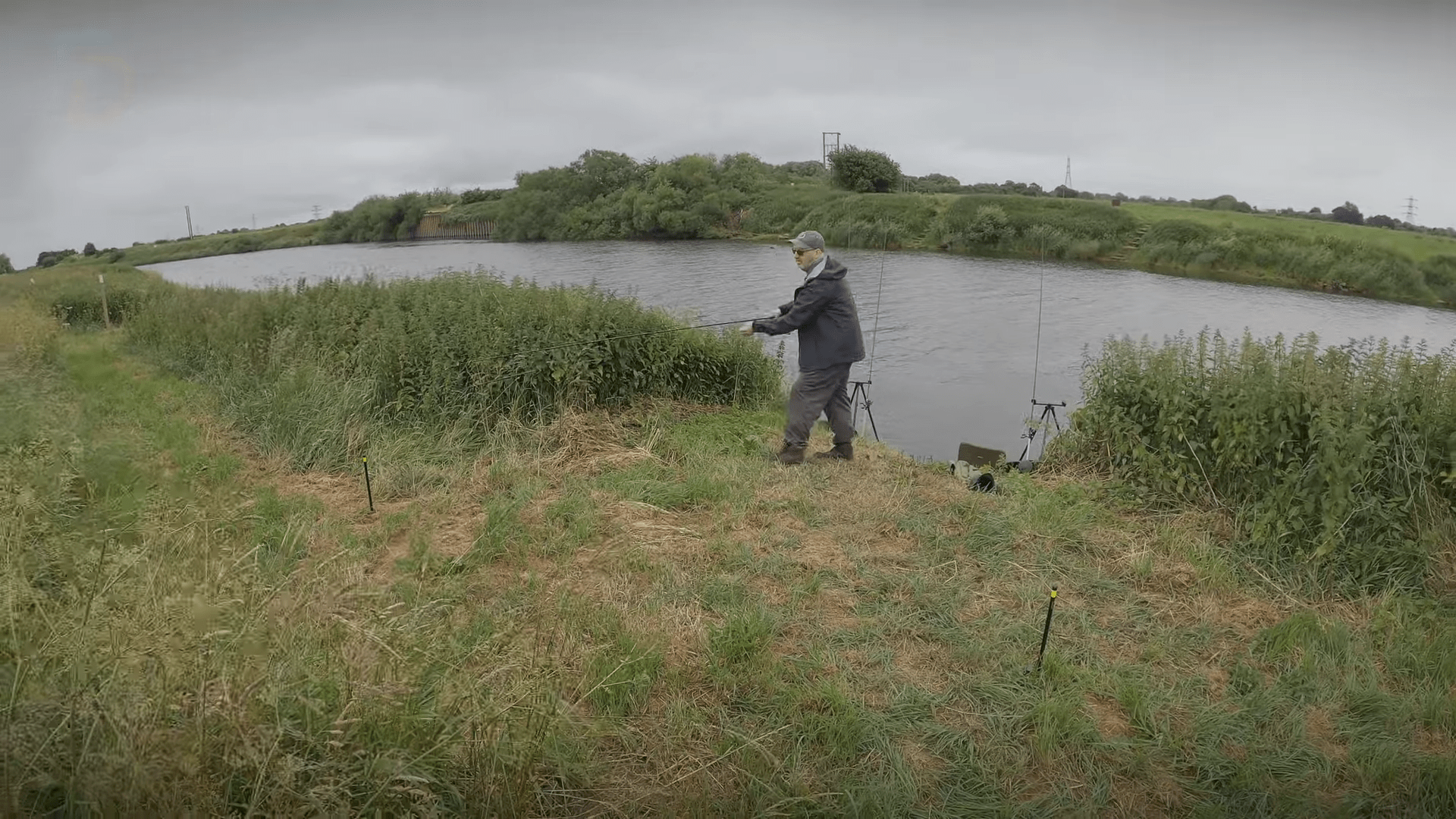
Wrapping line (figure of 8 style) around the "distance sticks" in the foreground
When you’re clipped up at your chosen distance you can cast in ten or more large swimfeeder’s worth of bait in rapid succession (without attaching a hook length). This puts all the bait quite accurately in the same area and all you need to do is attach a hook length and cast your baited rig out the same way... just remember to unclip the line once your baited hook is in the water or you could lose your rod to a three foot twitch of a bite and potentially leave a fish towing around your whole setup hook, lead, rod and reel.
When it comes time to recast (or if you get a fish) you can rewrap around the distance sticks and clip up to the same spot again. This gives you superb accuracy in daylight and obviously makes life much easier in the dark.
If you’re going to be fishing into the hours of darkness on the Tidal Trent you really need to understand the risks that come with being on that river in the dark. If you’re not familiar with the tidal flows you can be caught out with changing river levels not to mention boat traffic in the dark.
Fishing a pair of rods with bite alarms while sleeping in a bivvy is the norm when carp fishing on still waters but if you opt for this approach on the river you may get a nasty surprise! Rods can get “wiped out” by boats at night and it’s not impossible (if you can sleep through your alarm) for a boat to empty your reel’s spool and pull your rod(s) in!
Don’t forget personal safety too... steep, often slippery banks and quickly changing water levels make for difficult footing in daylight hours... playing, landing and releasing fish in the dark can be dangerous for you (and the fish).
And then there’s the (albeit slim) possibility of the tidal bore...
Want More Content Like this Barbel Fishing Article?
Well, that just about wraps it up for this deep dive on barbel fishing - but if you want to keep gaining the advantages of cross-training in your fishing; check out the other articles in our three main hubs.
Let us know what you liked or disliked about this article - and what you want to see more of in the comments below!
JP

some superb information very well done.
[…] Comprehensive Blog post for barbel fishing: https://fishingdiscoveries.com/barbel-fishing/ […]
Fantastic article. Many thanks
Very kind of you to say and I’m really glad you found it useful.
Good luck with your future barbel trips!
Paul